Chapter 5 – Pythagorean Theorem
Map
1.1
1.19

Timeline
1.1
1.19
Introduction
The Pythagoren theorem is called after Pythagoras, a Greek mathematician who lived 570 to ca. 490 BCE. However, civilizations from Babylon to Egypt discovered the concept behind this theorem about one thousand years before Pythagoras. Apparently, there was no civilization in the world history that didn’t know or use the properties of the right-angled triangle, the properties that we now call the Pythagorean Theorem. This theorem represents one of the oldest mathematical developments in human history. We can even say that this theorem is as important and vital to human race as inventing agriculture or domesticating wild animals.
People from many different cultures throughout history had a lot of the same problems we have now–they needed to measure land and distances, build sturdy structures such as pyramids or houses, and dig canals for irrigation. These practical matters are what inspired the ancient mathematicians all around the world to discover the relationship between the sides of a right angled triangle. Digging canals, restoring land borders after flooding. building altars, building temples, measuring slopes of pyramids, measuring depth of rivers, building scaling ladders, and a myriad of other tasks that involved creating and measuring right triangles was impossible without learning about the theorem long before it got the name we recognize today.
China – The Legend of Yu the Great
How important is Pythagorean theorem? Listen to the 2000 old words from the old Chinese manuscript about the Yu the Great and the Gougu theorem (that’s how Pythagorean theorem is called in China).
“Emperor Yŭ quells floods, he deepens rivers and streams, observes the shape of mountains and valleys, surveys the high and low places, relieves the greatest calamities and saves the people from danger. He leads the floods east into the sea and ensures no flooding or drowning. This is made possible because of the Gōugŭ theorem.”
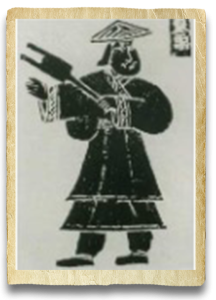
The Yellow River is considered by many as the cradle of Chinese civilization. Often referred to as “China’s Pride,” it spans over five thousand kilometres and is one of the longest river systems in the world. How is it possible then, that the ancient Chinese saw the river as a curse, even going as far as to name it “China’s Sorrow”?
Four thousand years ago, during the reign of King Yao, the Yellow River was the cause of mass flooding events that frequently demolished settlements and displaced the ancient residents of the Chinese heartland. King Yao tasked an engineer named Gun with the job of taming the mighty river. Gun spent nine years creating a series of dikes and dams to control the flow of the river, but he was ultimately unsuccessful. When Gun’s son, Yu, reached adulthood, he chose to pursue his father’s work with the aim of saving the Chinese people from the plague of floods caused by the Yellow River.
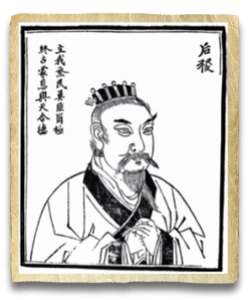
Yu teamed up with a mysterious agricultural master named Hou Ji, and together they created a system that actually worked to control the flooding of the river! Rather than directly damming its flow, Yu installed a sequence of irrigation canals that diverted flood water into the surrounding fields in small enough amounts that it wouldn’t overwhelm the land. On top of irrigation, Yu also dredged the riverbed of sediment and debris to improve the flow of the waterways. It is said that Yu spent thirteen years dredging the river – eating, sleeping, and labouring alongside the common workers. Their effort was a complete success, ushering in a new era of prosperity free from flooding in ancient China. The project earned Yu great acclaim, and is referred to in Chinese history as “Great Yu Controls the Waters.” However, Yu’s success was not without sacrifice.
Beyond the toll the project took on Yu’s body, he suffered a much greater burden emotionally. After being married for only four days, duty called on Yu to commit himself to fight the floods. He left home telling his wife he did not know when he would return. In the thirteen years he dedicated to subdue the flooding, he passed by his family’s home only three times, but never went inside. The first time, he could hear his wife giving birth to their son. The second time, he overheard his young son crying. The third time, he witnessed his ten-year-old son grieving about life without a father. Despite the pain Yu experienced, he put his duty ahead of himself, believing that he could not enjoy the peace of life with his family while the flooding was destroying the lives of thousands more families.
The emperor of China found Yu’s selflessness and dedication to the welfare of the Chinese people above his own needs to be so impressive that he selected him as the next emperor. Yu was uncertain at first, but after overwhelming support from his community he conceded and became the heir to the throne. The Legend of Yu the Great tells the story of how one man devoted his life to the service of others. It is a lesson in duty and self-sacrifice, and the idea that with great power comes great responsibility…
5.1
1.1
5.1
Solve the ancient Chinese math problem and you’ll see how the Gougu theorem helped Yu to determine the depth of the rivers and canals.
In the center of a river whose width is 10 chi (a chi is 1/3 of a metre) grows a reed whose top reaches 1 chi above the water level. If we pull the reed towards the bank, its top is even with the water’s surface. What is the depth of the river?
Egypt – Egyptian Afterlife
The pyramids of Egypt are iconic symbols of the ancient Egyptians’ obsession with the afterlife. These monumental structures were built to house the tombs of the pharaohs, serving as their gateways to heaven. But, did you know that not only pharaohs built tombs for themselves? Even average ancient Egyptians were busy preparing tombs for their journey to the next life. However, passage to the afterlife was not guaranteed, and the road was paved with danger and uncertainty.
In ancient Egypt, death was seen as the beginning of a voyage to a new world. The ancient Egyptians believed that their spirits would live on for forever in a paradise they called the Field of Reeds. Departing from the common view of heaven as a place of ecstasy, the Field of Reeds was another version of life on earth. The newly dead were given a plot of land and expected to plant and harvest crops, worship the gods, and live much like they had before they died. But, first they would have to get in. In order to gain admission into eternity they had to do two things: Firstly, while on earth, they had to live a morally upright life where they committed as few sins as possible. Secondly, they had to build a tomb, known to them as “houses of eternity,” and, after they died, embark on the harrowing journey to the afterlife.
Following death, a person’s soul would travel to the Hall of Truth guided by Anubis, the god of the dead. Once there, it would wait in line for the final judgment by the god Osiris. When facing Osiris, the soul would have to testify that it never committed any of the forty-two sins outlined by the gods in a ceremony called the Negative Confessions. Some of the sins include:
I have not done people wrong.
I have not impoverished my fellows.
I have not learned false things.
I have not done evil.
I have not deprived a poor man of his property.
I have not caused pain.
I have not created hunger.
I have not caused tears.
I have not killed.
I have not given orders to kill.
I have not slept around.
I have not created suffering for anyone.
I have not committed fraud.
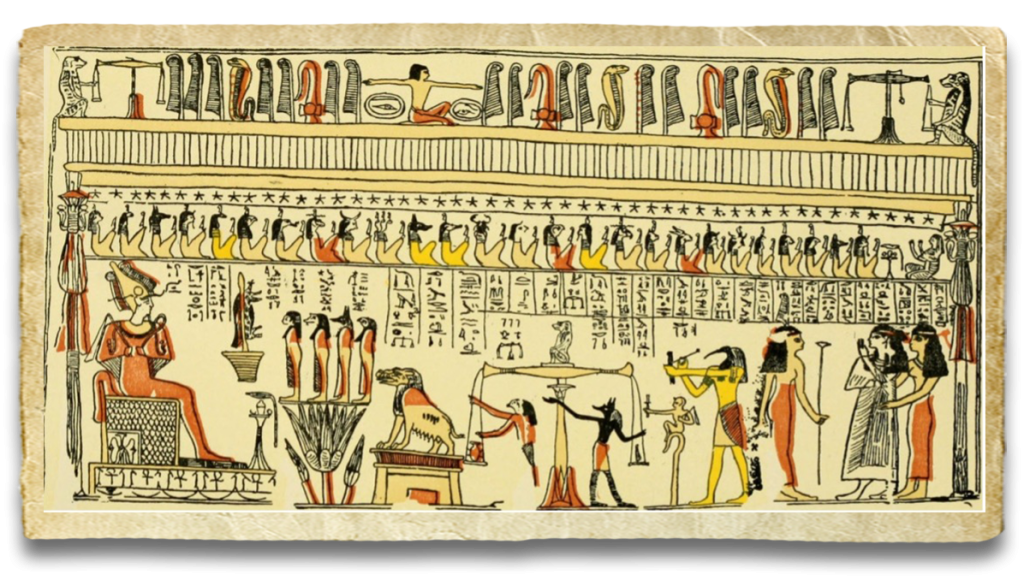
After the Negative Confessions ritual, the gods Osiris, Thoth, Anubis, and the Forty-Two Judges would discuss the soul’s testimony. If they ruled that the confession was accurate, the soul would make it to the next step and Osiris would weigh its heart on a golden scale against the feather of truth. If the soul’s heart was lighter than the feather, it would be granted access to eternity in the Field of Reeds. But, if the heart was heavier, it was thrown onto the ground and eaten by Ammut, “the female devourer of the dead,” and the soul would undergo “The Great Death” – a state of total non-existence. The ancient Egyptians had no concept of hell, feeling no need for it since non-existence was considered the ultimate punishment.
5.2
1.1
5.2
Given a pyramid 300 cubits (a royal cubit is 52.5 cm) high, with the square base 500 cubits on a side, determine the distance from the center of any side to the apex.
5.3
1.1
5.3
A pyramid has a base of 360 cubits (a royal cubit is 52.5 cm) and a height of 250 cubits. What is its seqt (the ratio of vertical and horizontal dimensions)?
5.4
1.1
5.4
Find the height of a square pyramid with a seqt (the ratio of vertical and horizontal dimensions) of 21 fingers per cubit (cubit equals 28 fingers) and a base of 140 cubits (a royal cubit is 52.5 cm) on one side.
5.5
1.1
5.5
A rectangular plot is 60 cubit (a common cubit is 40 cm) square; the diagonal is 13 cubits. How many cubits does it take to make the sides?
5.6
1.1
5.6
An erect pole of 10 cubits (a common cubit is 40 cm) has its base moved 6 cubits. Determine the new height and the distance the top of the pole is lowered
India – Lilavati, the Beloved Daughter
Can the love for your daughter become a reason to write a mathematical textbook? This the story of the Indian mathematician Bhaskara and his daughter, Līlāvatī.
Bhaskara lived 900 years ago and was one of the best mathematicians of his time. He lived with his wife on the banks of a beautiful lotus pond. Bhaskara’s wife delivered a baby girl who they named Lilavati which meant charming or graceful. Lilavati was a very beautiful and intelligent child. As she grew up the little girl asked her father many questions and gained a lot of knowledge this way.

When the time came, Lilavati became a bride and the day of the wedding was set. Before the wedding day, Bhaskara inspected Lilavati’s horoscope. He was shocked when he found out that Lilavati would not have a happy married life if she did not get married at a particular lucky time. He did not tell Lilavati about this, as he didn’t want to spoil his daughter’s happy mood. He decided to make all arrangements to make sure that Lilavati would get married at this specific lucky time. In order to make sure that he did not miss this particular time, Bhaskara tuned his water clock the way that it would stop exactly at the lucky time. Hoe the water clock work, you would ask? One small bowl is floating in the second bigger bowl filled also with water. The small bowl had a tiny hole at the bottom. Water sipped through the hole and when the small bowl fills in and becomes too heavy to float it would sink to the bottom. Bhaskara arranged so that the bowl would sink exactly at the beginning of the destined lucky hour. He asked Lilavati not to go near the clock but didn’t tell her the reason.When Bhaskara was not around, Lilavati, could not hold her curiosity and went to see what her father had devised.When Lilavati approached the clock, she bent forward to get a closer look. A little pearl from her nose ring fell into the water. She rushed back in a hurry so that her father would not find out what she was up to.
The little pearl fell into the water and the bowl became heavier and sank before the time set by Bhaskara. The wedding took place, but not at the only hour that could avoid the disaster. And as destined, Lilavati’s husband died a few days after the marriage.
Lilavati lost all her joyousness. She sat by the pond looking into nothingness and wept. She remained silent most of the time. Bhaskara found it very difficult to see these changes in his beautiful daughter. One day, Bhaskara had an idea. He posed a mathematical puzzle to her and said, “Lilavati! Why don’t you solve this problem? You have always been interested in solving problems. Take it as a challenge and do it.”
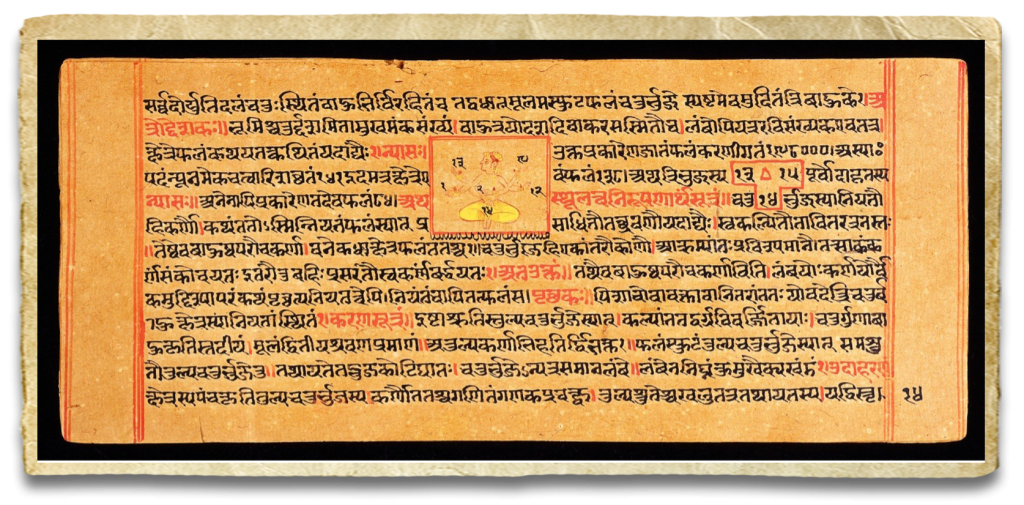
Lilavati agreed. As she got involved in solving the problem, she was totally drawn into it. She felt alive when she solved it. Bhaskara kept posing mathematical problems to Lilavati. Step by step, her dejection and depression disappeared. Lilavati felt like she was born again. Her mind was busy by solving the problems posed by her father and never again she got depressed. And it is believed that the problems posed to Lilavati form the major portion of Bhaskara’s book which is named after her.
And this is the story behind “Lilavati” – the book that served as the main textbook for arithmetic and geometry in India for many centuries.
5.7
1.1
5.7
There is a hole at the foot of a pillar 9 hastas ( a hasta is 45 cm) high, and a pet peacock standing on top of it. Seeing a snake returning to its hole at a distance from the pillar equal to three times its height, the peacock swoops down upon the snake slantwise. Say quickly, how far from the pole does the meeting of their paths occur?
5.8
1.1
5.8
A fish is resting at the northeast corner of a rectangular pool. A heron standing at the northwest corner spies the fish. When the fish sees the heron looking at him, he quickly swims towards the south. When he reaches the south side of the pool, he has the unwelcome surprise of meeting the heron who has calmly walked due south along the side and turned at the southwest corner of the pool and proceeded due east, to arrive simultaneously with the fish on the south side. Given that the pool measures 12 units by 6 units, and that the heron walks as quickly as the fish swims, find the distance the fish swam.
5.9
1.1
5.9
One monkey came down a tree of height 100 and went to a pond a distance of 200. Another monkey, leaping some distance above the tree, went diagonally to the same place. If their total distances traveled are equal, tell me quickly, learned one —if you have a thorough understanding of calculation- how much is the height of the leap?
5.10
1.1
5.10
In a certain lake swarming with red geese, the tip of a lotus bud was seen to extend a span [9 inches] above the surface of the water. Forced by the wind, it gradually advanced and was submerged at a distance of 2 cubits [40 inches]. Compute quickly, mathematician, the depth of the pond.
Medieval Europe – Game of Thrones and the War of Roses
In 15th century England, a decades-long series of battles known as the Wars of the Roses saw two royal families pitted against each other for control of the country. Throughout all the drama, bloodshed, and betrayal, could they have possibly imagined their conflict would serve as the inspiration for a hit TV show centuries later?
The Wars of the Roses was given its name because both of the families responsible for the war used a rose as their emblem: the House of York, a white rose, and the House of Lancaster, a red rose. The Yorks and the Lancasters each felt they had a right to rule the country since they were both descendents of the royal Plantagenet family bloodline.

At the start of the war, the House of Lancaster ruled England under the reign of King Henry VI, but by 1460, were briefly unseated by the army of Richard, Duke of York, who was later killed in battle. Shortly thereafter, the Yorks had dealt a decisive military blow to the Lancasters, and installed Edward IV as England’s new king.
Much of the Yorks’ success was owed to the Earl of Warwick. Despite helping Edward IV become king, the Earl of Warwick disagreed with him on many issues, and ultimately double-crossed him, teaming up with Edward’s own brother, the Duke of Clarence, to overthrow him and retake power for themselves. Unfortunately, their attempted coup failed, and they were forced to flee to France where they joined forces with the exiled former Queen Margaret of the House of Lancaster. After regrouping, these three unlikely allies summoned their armies and invaded England. Just when victory seemed certain, betrayal reared its ugly head when the Duke of Clarence again changed sides and realigned himself with the House of York! The Earl of Warwick was killed in battle, the former Queen Margaret was captured, and her husband, the previous king Henry VI, and his sons, were all executed.
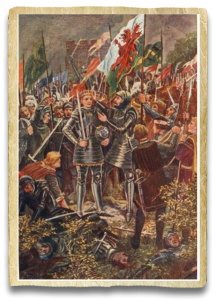
After being dethroned for a short time in 1470, Edward the IV quickly won back his title as king, and ruled for several years of moderate peace. Following his death in 1483, the carnage of the previous decades reappeared. New contenders for the throne eagerly sought to fill the power vacuum, and within a short time King Edward’s heirs were assassinated, and only two candidates for king remained: the Yorkist, Richard III, and the Lancastrian, Henry Tudor. When Richard III attempted to seize power, many of his allies changed sides and pledged allegiance to Henry Tudor. Tudor attacked Richard III’s forces on August 22, 1485 at the Battle of Bosworth Field. The bloody confrontation ended in an unquestionable Tudor victory, with Richard III killed during battle from a brutal strike to the head. Tudor was promptly crowned King Henry VII, ushering in a new Tudor Dynasty that prospered until the early 1800s. The peaceful new era was largely attributed to Henry uniting the Yorks and Lancasters by marrying Elizabeth of York, Edward the IV’s daughter.
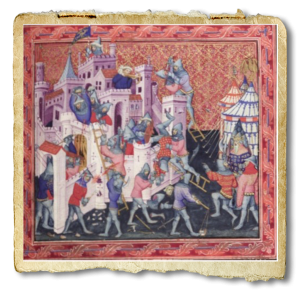
In an attempt to put a symbolic end to the Wars of the Roses, he created a “Tudor rose” emblem by combining the white rose of the Yorks with the red of the Lancasters.
Some of the strongest works of fiction are often adapted from real historic events. It’s no surprise then, that the epic drama of the Wars of the Roses, with all of its plot twists, acts of treachery, and sheer brutality, went on to inspire Game of Thrones. The question is, do we owe history our thanks? Or is there a more somber moral to the story?
5.11
1.1
5.11
A siege, or scaling, ladder would have been used to enable fighters to climb to the top of a fortification wall and gain access to the interior of a defensive position. A siege ladder would need to be tall enough to reach the top of the wall. It would be carried to the base of the wall as closely as possible and tilted over so that the top of it could rest on the top of the wall. At the same time its angle had make it difficult for the defenders to push a ladder backward. All these considerations had to be taken into account when building a siege ladder. No wonder medieval students were learning how to solve the problems that require the knowledge of the Pythagorean Theorem. For example, their textbooks would have illustrations that have the Pythagorean triangles in them:
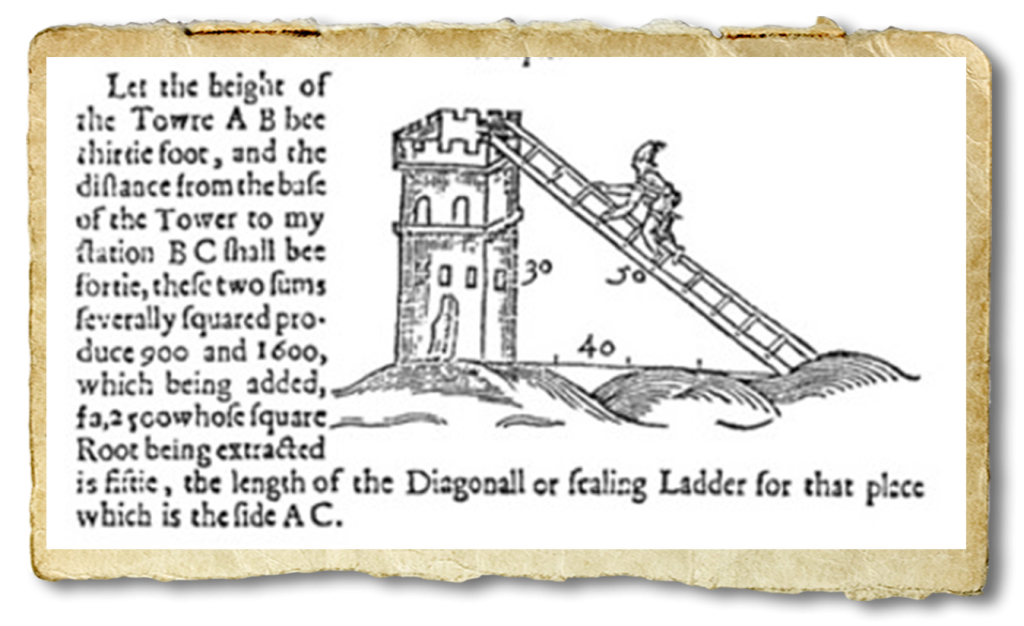
Two towers, the heights of which are 30 paces and 40 paces, are 50 paces apart. Between the two towers there is a font where two birds, flying down from the two towers at the same speed will arrive at the same time. What is the distance of the font from the two towers?
